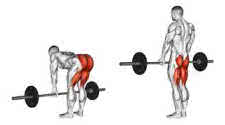How to Perform Exercises Correctly: The Romanian Deadlift Exercise

Correct Exercise Executions for Ultimate Lasting Results
About two years ago, at a sports medicine symposium, I learned about a new type of lift. It seemed quite useful, and I'm surprised that it's still relatively unknown. It's called the Romanian deadlift, and it was
named for Dragonmir Cioroslan, the former national-level Romanian weightlifting coach who won the bronze medal in his weight class at the '84 Olympics and is now the head coach of the United States Olympic
weightlifting team. In 1990 Cioroslan was performing the lift at the U.S. Olympic Raining Center, and the weightlifters and others coaches began to gather round to watch.
Dragonmir was surprised that they'd never seen it before. Michael Reed, D.C., of Grover City, California, is a doctor for the team and was present when this incident took place. "The Romanian deadlift was
developed to help the first part of the pull of a clean or a snatch," explained Reed, who is a sports medicine specialist and a certified Strength and Conditioning Specialist. "I think that it's a great lift
for the erectors, glutes and hams, You'd be surprised by how many experienced lifters begin this lift carefully and still experience a great deal of soreness in these muscles.
All of the Olympic weightlifters perform this lift today. Deke Anderson demonstrates the Romanian deadlift in the accompanying photos (not currently available, sorry for the inconvenience, check back soon!). It's
performed similarly to the stiff-legged deadlift.
You begin by standing completely upright, holding the bar at arm's length in front of your thighs, as you would if you were doing stiff-legged deadlifts or shrugs. Holding your back completely flat, bend
forward, letting all of the motion occur at the hip joint. Keep the bar close to your thighs and legs and continue as far as your flexibility will allow without bending your knees too much. The key here is
that you must not round your back at all. In the Romanian dead-lift you maintain a flat back throughout the movement.
Figure 1 shows Deke at the bottom position of a stiff legged deadlift. Note that his back is somewhat rounded. Compare that with Figure 2, in which he's in the midrange position of the Romanian deadlift and his
back is flat. In Figure 3 Deke demonstrates the incorrect midrange position-his back is rounded again.
"If you're not conditioned or prepared for this lift, then I'd advise you not to perform it," Reed continued. "If you do this lift and you're not prepared, you'll probably develop lower-back pain. If you're not
prepared, I'd suggest doing the base lifts of pulls, hypers, first pulls, deadlifts, stiff-legged deadlifts, cleans and snatches."
Lifters who are at the other end of the spectrum are another story. "Those who are conditioned and are elite Olympic weightlifters will sometimes perform this lift five to six times per week. Please remember,
however, that these lifters are on carefully devised programs [designed by Cioroslanl and are supervised closely. This sometimes appears contrary to what we know to be physiological principles, hut the intensity
and volume are manipulated carefully, and that type of program is for the elite lifter only".
So how do the rest of us use this exercise? Perhaps we don't. "This is not a great exercise Reed cautioned. The performance of the Romanian deadlift needs to be carefully supervised, and, I regret to say, this
is beyond the scope of the average personal trainer. There are many Certified Strength and Conditioning Specialists who are not qualified to teach or supervise this lift."
Advanced bodybuilders, however, may have great use for it. "One area that many bodybuilders have a deficiency in is their erectors," Reed continued, "The Romanian deadlift would be excellent to include in the
hypertrophy stage of training, then, when the contest is close, they could do it occasionally."
Even so, he cautioned against performing high reps when working this area of the body because it 'would certainly place the back at high risk of injury," he said. "1 would start a national-level Heavyweight
bodybuilder with an empty Olympic bar (only 45 pounds, and I would train the athlete for the motion. Then a few workouts later 1 would add a 25-pound plate to each side and watch the motion.
After that I would have the athlete go to a 45-pound plate on each side, again watching for correct motion. You will be surprised that you get sore from these lighter weights even if you've been performing the
stiff-legged deadlift. The added erector and hamstring development is significant."
Powerlifters should have great use for this lift as well. Remember that it was designed to help the first pull phase of a clean, so there should be some carryover to the start, or initial pull, on the deadlift.
As Reed indicated, bodybuilders can incorporate the Romanian deadlift into their routines during the hypertrophy stage of training. If you are an average or better-than- average trainee and you wish to use this
lift, keep your back flat and stretch only as far as you feel comfortable. Do not overstretch during this movement. On that subject you can refer to my columns on erector spinae and the one on the power clean
mentioned above.
Start with very light weights and progress slowly. If you already have a lower-back injury you may want to pass on this one. If not, try performing it once a week or twice at most, with one of the workouts
being lighter. Your recovery ability and time are important factors.
The Romanian deadlift is a relatively new exercise to American trainees. If you're a national- or elite-level trainee, consider including it in your program.
Don't ignore it!